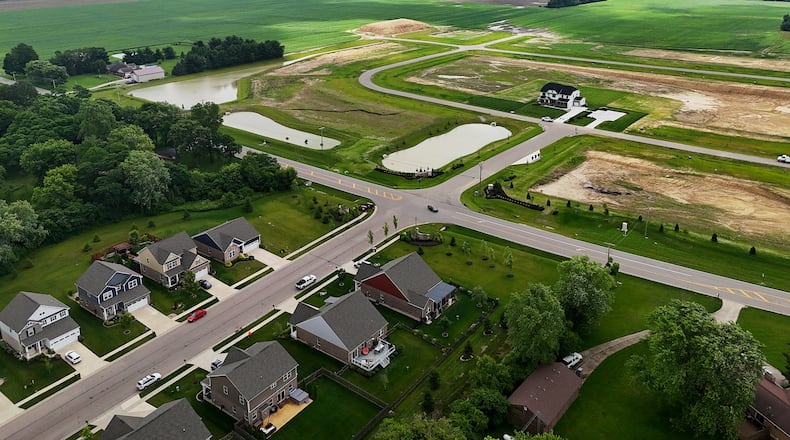In 2023, Ohio had 13.7 million acres of land in farms, and in 2024, that dropped to 13.5 million acres, the U.S. Department of Agriculture’s National Agricultural Statistics Service reported.
A key driver of agricultural land conversion in the state is urban growth at city boundaries.
Southwest Ohio sees housing boom
Warren (third), Butler (fourth) and Montgomery (eighth) counties are in the top 10 Ohio counties by agricultural land loss to development between 2000 and 2023, according to a report released in April by Ohio State University’s College of Food, Agricultural and Environmental Sciences.
Between 2000 and 2023, the Dayton, Kettering and Beavercreek area lost 24,021 acres of land to development, dropping from 486,726 to 460,819 acres of farmland, and Springfield lost 5,265 acres to development, going from 176,493 to 170,579, the report stated.
There has been a residential housing boom across Southwest Ohio for decades.
Credit: Joseph Cooke
Credit: Joseph Cooke
Northern Warren County, particularly Springboro and Clearcreek Twp., has seen more than 600 new single-family houses built or coming soon from developments approved since 2024.
Springboro and Clearcreek Twp. are attractive to many as suburbs of Dayton and Cincinnati, easily accessible from Interstate 75. Springboro Schools are among the top-rated districts in the Miami Valley, and the area has restaurants, shopping and parks in addition to other recreation opportunities.
Credit: Nick Graham
Credit: Nick Graham
“Clearcreek is really kind of a microcosm of the larger issue, which is Dayton and Cincinnati growing together,” said Jason Gabbard, a Clearcreek Twp. trustee who lives on his 12-acre family farm that five generations ago was 700 acres.
“Progress is inevitable,” said Gabbard, who added that ultimately it is a property owner’s right to choose whether to develop farmland or sell it to developers.
“That being said, we have oversight as to what that looks like within the parameters of what it’s zoned,” he said. “I don’t want to see more rooftops than is allowable.”
Some worry about losing ‘small-town charm’
For local governments, new housing developments present challenges and can put a strain on road infrastructure, water and sanitary sewer, emergency services, school systems and other services.
Existing residents worry about increased traffic, and especially in smaller towns, loss of community identity.
Jaime Iaquinta of Brookville was involved in the grassroots Brookville Citizens for Keep It Rural movement of residents concerned about rapid development and expansion.
“People were just concerned about the small-town charm and rural community just disappearing because of all of this housing construction coming in,” she said. “We get the economic impact, increasing tax base, but we are losing our small-town charm.”
Credit: Bryant Billing
Credit: Bryant Billing
The group successfully pushed back against a higher-density housing development so now the new subdivision will have half-acre lots. Also, the city in January announced a moratorium on annexations while it creates a new land use plan.
Developer Joe Cristo, president of Cristo Homes based in West Chester Twp., said the Cincinnati-Dayton housing market is highly competitive with the presence of many national builders.
“New home developments are positive for a community because people tend to invest within the communities in which they live. It brings more people, which calls for more growth in the community,” he said.
Credit: Nick Graham
Credit: Nick Graham
Cristo, who runs the family business that’s been around since the 1960s with his younger brother, Adam, acknowledged that some communities are more open to growth and others are more resistant.
“We try to identify the communities that are receptive to our developments and appreciate the growth that will bring,” he said.
Economic development means jobs, tax base
The Dayton Development Coalition, which is not involved in housing developments, has a mission to retain, expand and attract jobs in the region.
“The benefits of economic development include providing jobs for regional residents, diversifying our local economy to better insulate it from downturns, adding to the regional tax base, and the extended economic impact of businesses and employees buying goods and services from existing local businesses,” said Shannon Joyce Neal, DDC vice president of strategic communications.
“A good example of the ripple effect is capital investment. When a company expands their building or builds a new one, they often use local firms for the construction.”
She said economic development also allows communities to respond to changing industries and economic conditions by supporting growing industries.
“Examples of this in the Dayton region include the growth in the advanced air mobility industry and electric vehicle industry. We want our community to attract the jobs of the future so we’re not left behind as industries transform,” she said.
The coalition website has a site search tool for available buildings and vacant land, with information provided by property owners for the listing.
Some of the vacant parcels have gone through a rigorous process with JobsOhio, called SiteOhio, that are zoned and ready for development. Other times properties require zoning changes, in which case those involved must follow the legal process to make those changes that ultimately is up to the community, Joyce Neal said.
“The DDC works in partnership with local communities and property owners when we work with companies establishing new facilities on undeveloped land. Zoning helps everyone understand where a community wants commercial or industrial property and helps economic development organizations better guide companies to sites where their investment would be welcomed,” she said.
Food and agriculture Ohio’s largest industry
Land is one of the most valuable resources within the agriculture sector.
The 2022 U.S. Census of Agriculture, a report taken every five years, recorded 76,009 farms in Ohio with a collective 13,652,346 acres that generated $15.4 million in market value of agriculture products sold statewide.
Food and agriculture together are the state’s largest industry and contribute more than $105 billion a year to the state economy and provide jobs to one in seven Ohioans, according to the Ohio Department of Agriculture.
Credit: Jim Noelker
Credit: Jim Noelker
To maintain Ohio’s land-based industry and related benefits, the ODA’s Office of Farmland Preservation educates the public about the importance of saving this resource and assists farmers and local officials with farmland protection efforts.
Easement programs began in 2002 that allow property owners to enter into legal agreements that prohibit any future non-agricultural development by landowners.
Alan and Renee Winner of Winner Family Farm in Pleasant Twp. near De Graff in Logan County placed an easement on their farm.
“We believe it’s important to preserve Ohio’s farmland because they aren’t making new farmland,” Renee Winner said in a YouTube video produced by the ODA.
The Winner farm is among more than 540 farms with a combined more than 85,000 acres in 61 counties preserved as of 2020, the office reported.
Acres of farmland lost between 2000 and 2023 by county:
Warren: 20,262
Butler: 18,040
Montgomery: 10,555
Greene: 7,376
Miami: 6,090
Clark, 5,265
Darke: 3,975
Champaign: 2,517
Preble: 2,459
Source: Ohio State University’s College of Food, Agricultural and Environmental Sciences
Number of farms in 2022 by county:
Butler: 888, land in farms 93,238 acres
Champaign: 839, land in farms 217,289 acres
Clark: 833, land in farms 170,922 acres
Darke: 1,761, land in farms 366,642 acres
Greene: 897, land in farms 156,287 acres
Miami: 1,158, land in farms 166,746 acres
Montgomery: 789, land in farms 118,582 acres
Preble: 1044, land in farms 213,053 acres
Warren: 872, land in farms 101,621 acres
Source: USDA’s National Agricultural Statistics Service
About the Author






